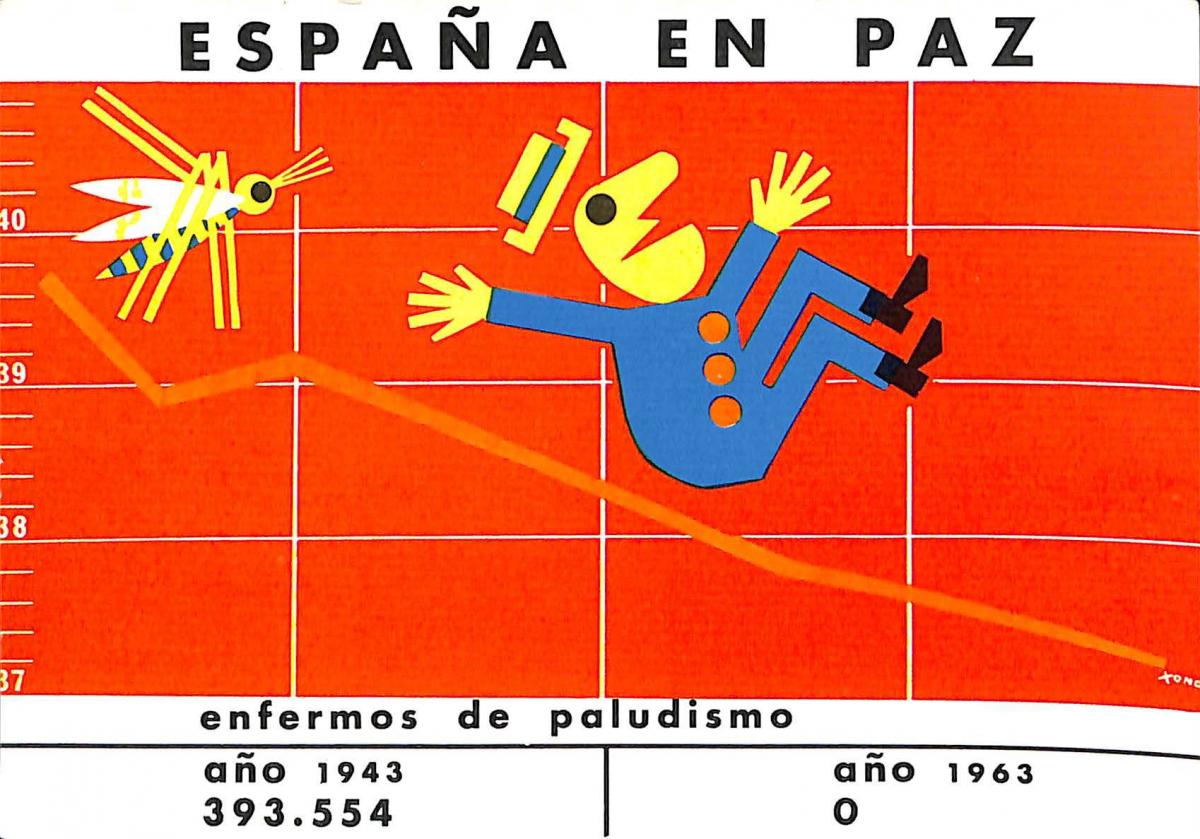 de Masdevall, J. Relación de las epidemias de calenturas pútridas y malignas. Edición facsímil de la obra original y su traducción en lengua inglesa. Barcelona: CRESIB, 2008.
de Masdevall, J. Relación de las epidemias de calenturas pútridas y malignas. Edición facsímil de la obra original y su traducción en lengua inglesa. Barcelona: CRESIB, 2008.
Facsimile edition prepared by CRESIB and Ars Medica of the work of Joseph de Masdevall originally published at the end of the 18th century. Joseph de Masdevall, a doctor from Figueres, proposed the antimonial mixture and the anti-febrile opiate as methods to fight the fever epidemic that devastated Catalonia in 1783.
 Iglesias y Díaz, M. Valor terapéutico de la quina y de las sales de quinina en las pirexias. Madrid: Imprenta de los señores rojas, 1878.
Iglesias y Díaz, M. Valor terapéutico de la quina y de las sales de quinina en las pirexias. Madrid: Imprenta de los señores rojas, 1878.
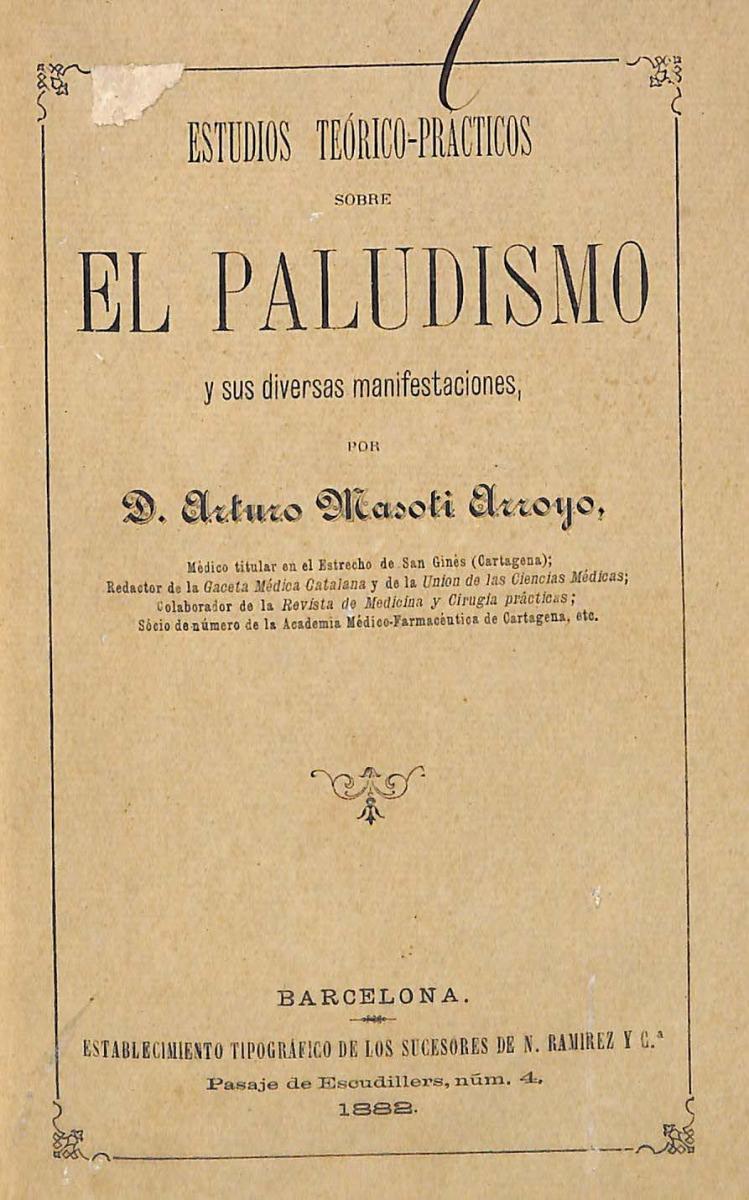 Masoti Arroyo, A. Estudios teórico-prácticos sobre el paludismo y sus diversas manifestaciones. Barcelona: Establecimiento tipográfico de los sucesores de N. Ramírez y Cª, 1882.
Masoti Arroyo, A. Estudios teórico-prácticos sobre el paludismo y sus diversas manifestaciones. Barcelona: Establecimiento tipográfico de los sucesores de N. Ramírez y Cª, 1882.
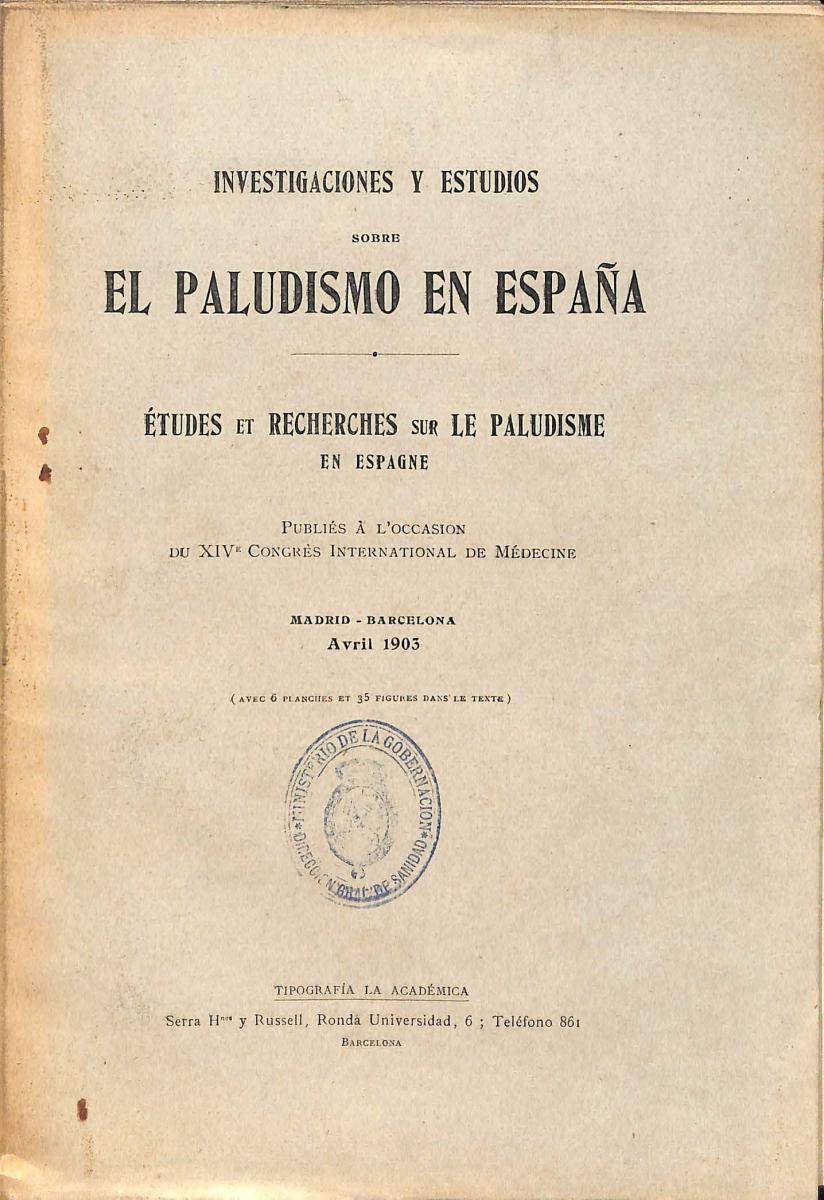 Pittaluga, G. Investigaciones y estudios sobre el paludismo en España. Barcelona: Tip. La Académica, 1903.
Pittaluga, G. Investigaciones y estudios sobre el paludismo en España. Barcelona: Tip. La Académica, 1903.
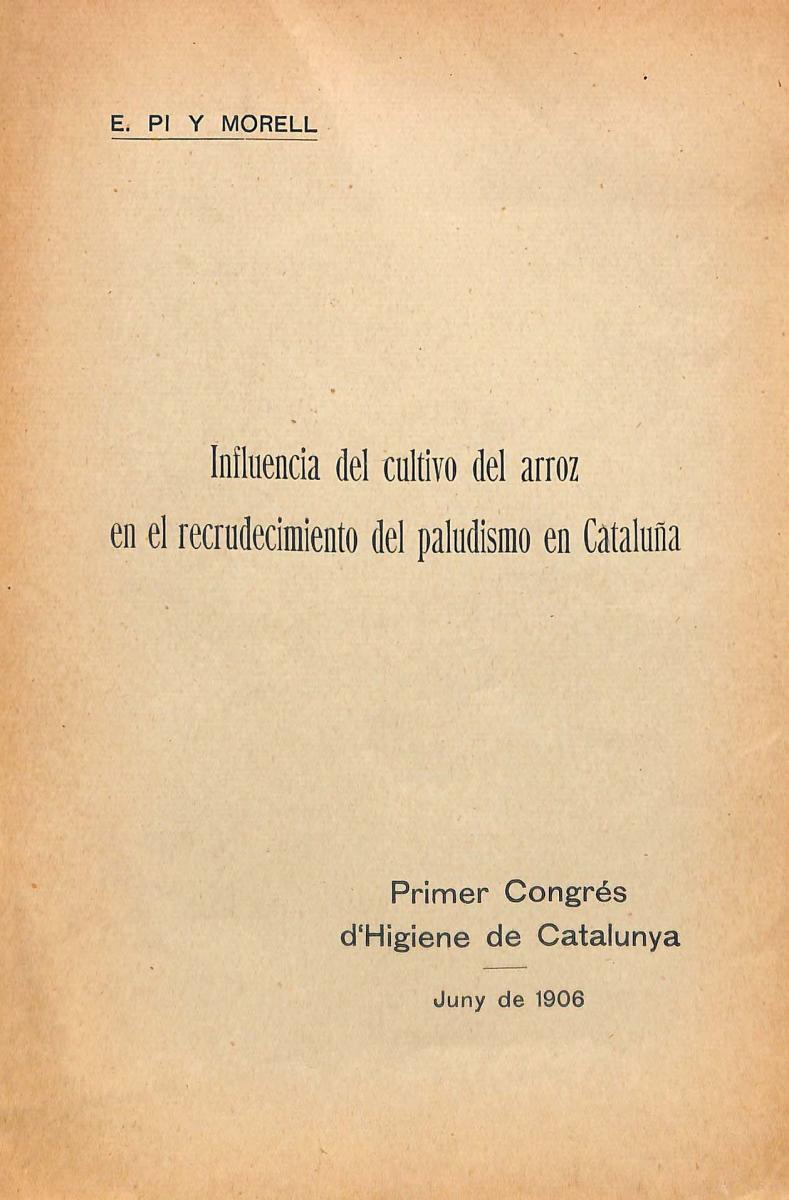 Pi i Morell, E. Influencia del cultivo del arroz en el recrudecimiento del paludismo en Cataluña. Academia d'Higiene de Catalunya, 1906.
Pi i Morell, E. Influencia del cultivo del arroz en el recrudecimiento del paludismo en Cataluña. Academia d'Higiene de Catalunya, 1906.
Paper by Dr. Enric Pi i Morell discussing the influence of rice cultivation on the worsening of malaria in Catalonia, presented during the first Hygiene Congress of Catalonia (June 1906). At the congress, the doctor responded to the accusations of the other attendees who said that the Catalan government should ban the cultivation of rice in that region for being notoriously harmful to public health.
 Mancomunitat de Catalunya. Treballs del servei tècnic del paludisme, 1915-1916. Barcelona: publicacions de l'institut de ciències, 1918.
Mancomunitat de Catalunya. Treballs del servei tècnic del paludisme, 1915-1916. Barcelona: publicacions de l'institut de ciències, 1918.
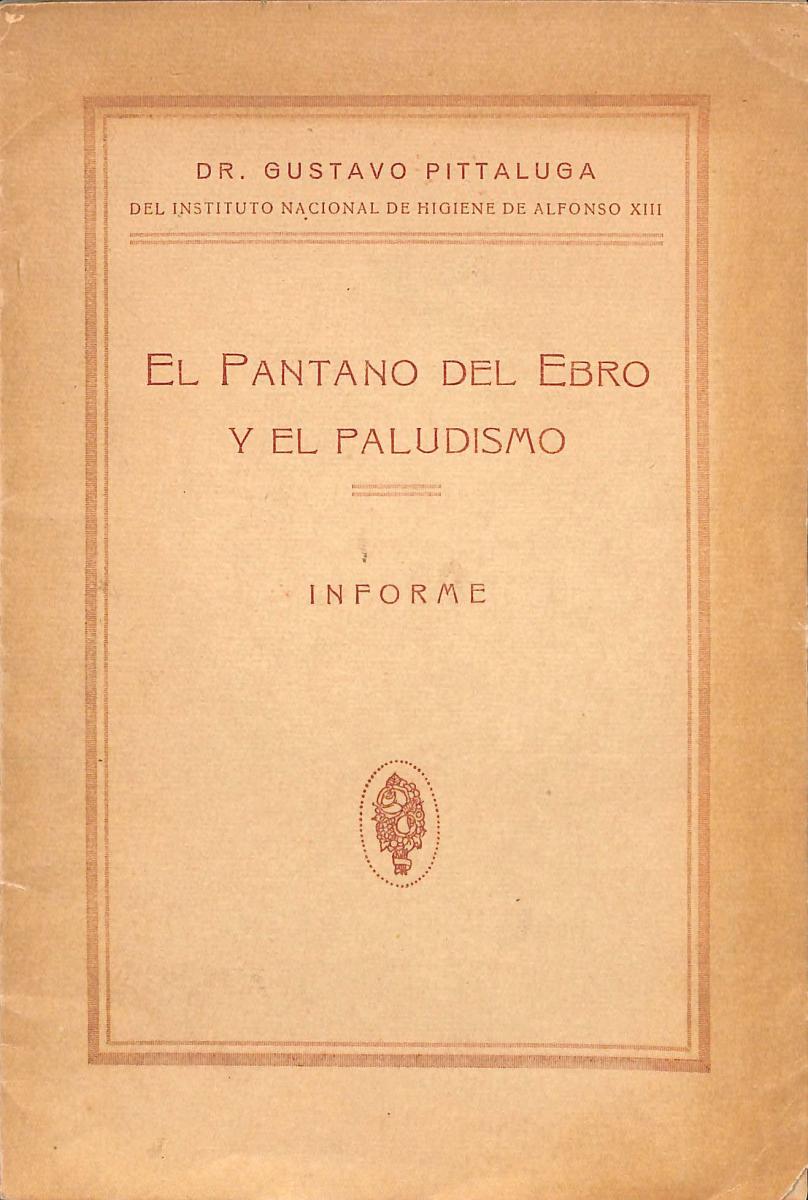 Pittaluga, G. El pantano del Ebro y el paludismo. Informe. Zaragoza, Tip. Y Fot. Del Heraldo Coso, 1919.
Pittaluga, G. El pantano del Ebro y el paludismo. Informe. Zaragoza, Tip. Y Fot. Del Heraldo Coso, 1919.
 Pastor Ojero, J. El paludismo en la zona del protectorado español en Marruecos y medios para combatirlo. Madrid: Talleres del Depósito de la Guerra, 1921.
Pastor Ojero, J. El paludismo en la zona del protectorado español en Marruecos y medios para combatirlo. Madrid: Talleres del Depósito de la Guerra, 1921.
Official report drafted by the commission in charge of the study of malaria in Morocco, made up of Dr. José Pastor Ojero and various collaborators such as Dr. Antonio Redondo, Eduardo Delgado, Julio Blanco, Ramón F. Cid and José Palanca.
 El Paludisme en el Baix Llobregat : actuació de la Comissió Mixta Executiva per a la lluita antipalúdica en el Baix Llobregat des de desembre de 1921 a novembre de 1922. Barcelona: Imp. de la Casa de Caritat, 1922.
El Paludisme en el Baix Llobregat : actuació de la Comissió Mixta Executiva per a la lluita antipalúdica en el Baix Llobregat des de desembre de 1921 a novembre de 1922. Barcelona: Imp. de la Casa de Caritat, 1922.
This work describes the casuistry and characteristics of the transmission of malaria in the Baix Llobregat, at the beginning of the 20th century. The Baix Llobregat has traditionally been one of the two epicenters, along with el Delta de l'Ebre, of malaria transmission in Catalonia. The extension of its marshy areas, for example around the grounds of the current airport, have facilitated the native proliferation of mosquitoes of the genus Anopheles. Native transmission currently does not occur as these mosquitoes do not find humans infected with the parasite, necessary to complete the transmission cycle.
 de Buen, S. Proyecto de organización de la lucha antipalúdica con aplicación a las condiciones hidrográficas y agrícolas de las distintas regiones de España. Madrid: Imp. de la Ciudad Lineal, 1925.
de Buen, S. Proyecto de organización de la lucha antipalúdica con aplicación a las condiciones hidrográficas y agrícolas de las distintas regiones de España. Madrid: Imp. de la Ciudad Lineal, 1925.
Sadí de Buen Lozano (Barcelona, 18 of July of 1893 - Cordova, 3 of September of 1936) doctor and Spanish scientist, was a parasitologist remarkable by his efforts in the study and the eradication of the malaria in Spain. His family was key in introducing prawns as a method of controlling mosquito larvae.
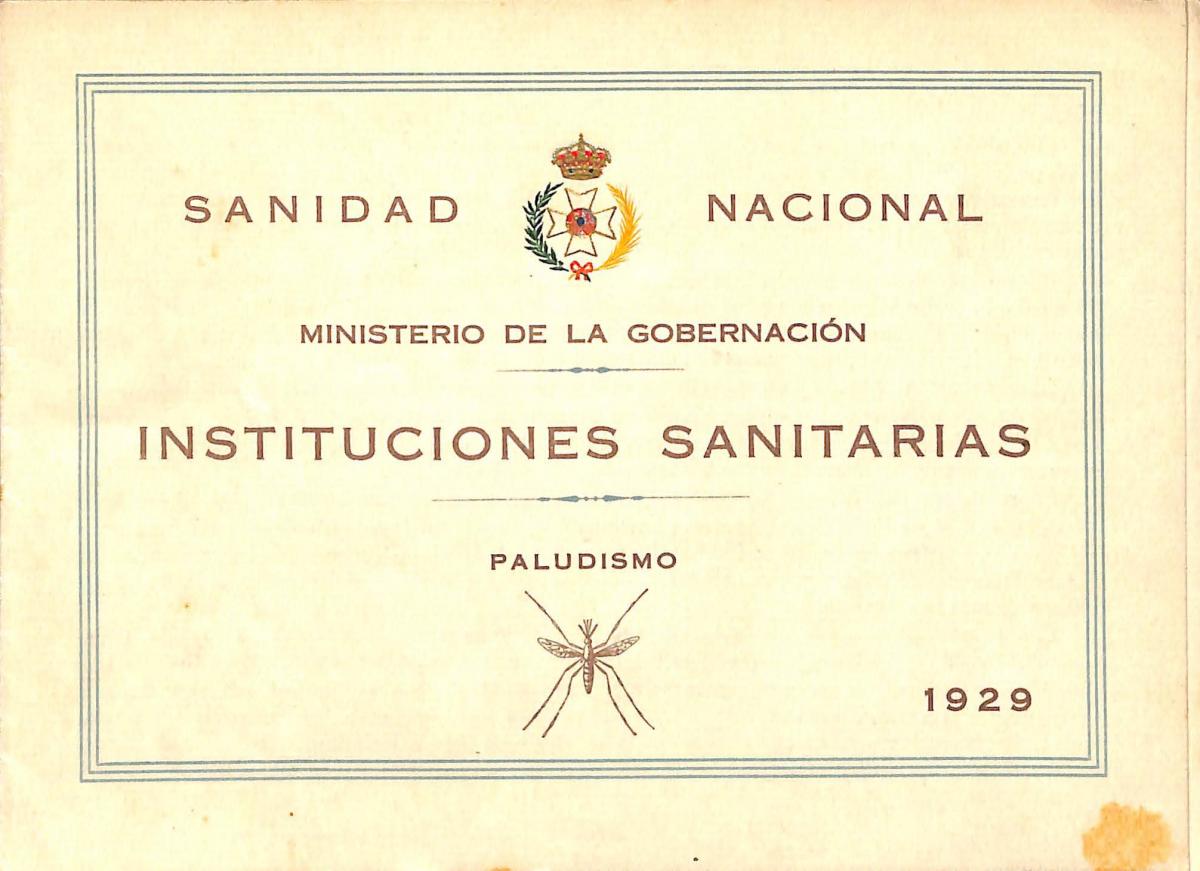 Paludismo. Ministerio de la gobernación, Instituciones Sanitarias, 1929.
Paludismo. Ministerio de la gobernación, Instituciones Sanitarias, 1929.
Brochure on malaria with morbidity and mortality statistics for 1929. The mainstay of the fight against malaria in Spain was the establishment of a complex network of antimalarial dispensaries throughout the territory and under strict control of the Comisión Central Antipalúdica.
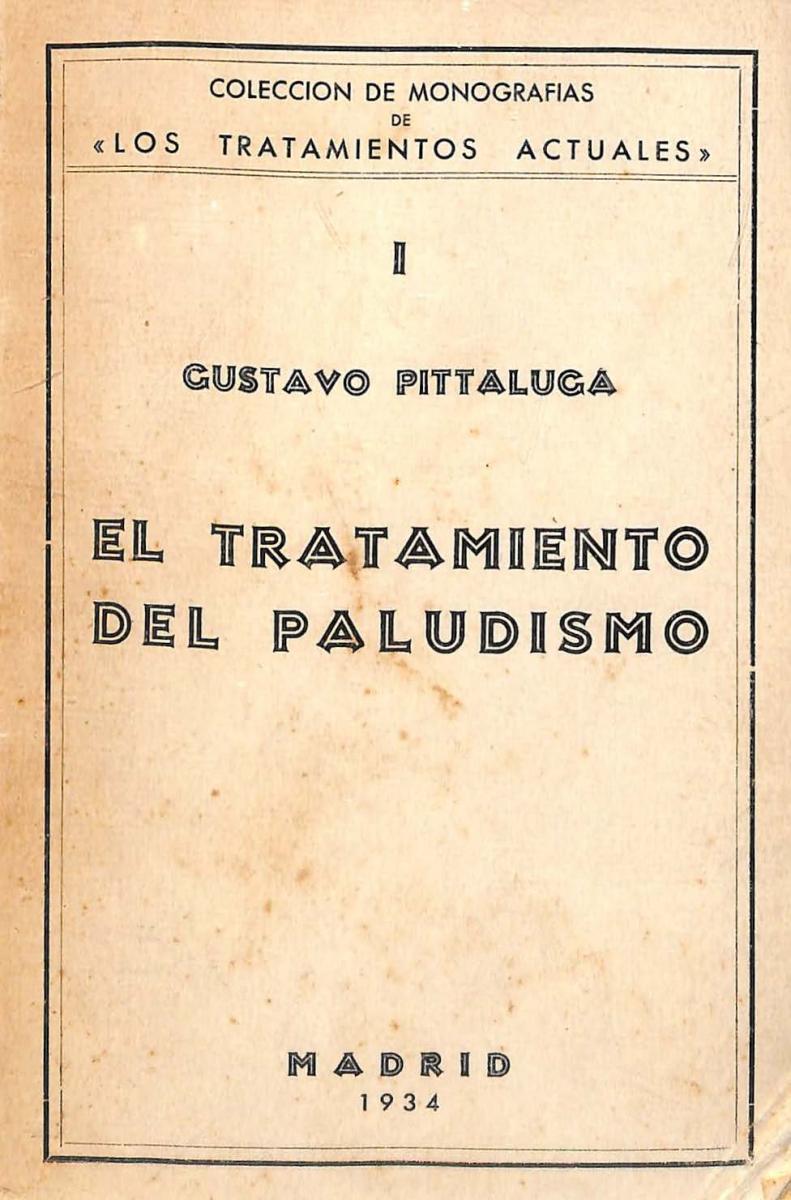 Pittaluga, G. El tratamiento del paludismo. Madrid, 1934.
Pittaluga, G. El tratamiento del paludismo. Madrid, 1934.
The Italian doctor Gustavo Pittaluga, nationalized as spaniard, created scientific institutions for the study of malaria in Spain and led campaigns to combat it from the Commission for the Sanitation of Malaria.
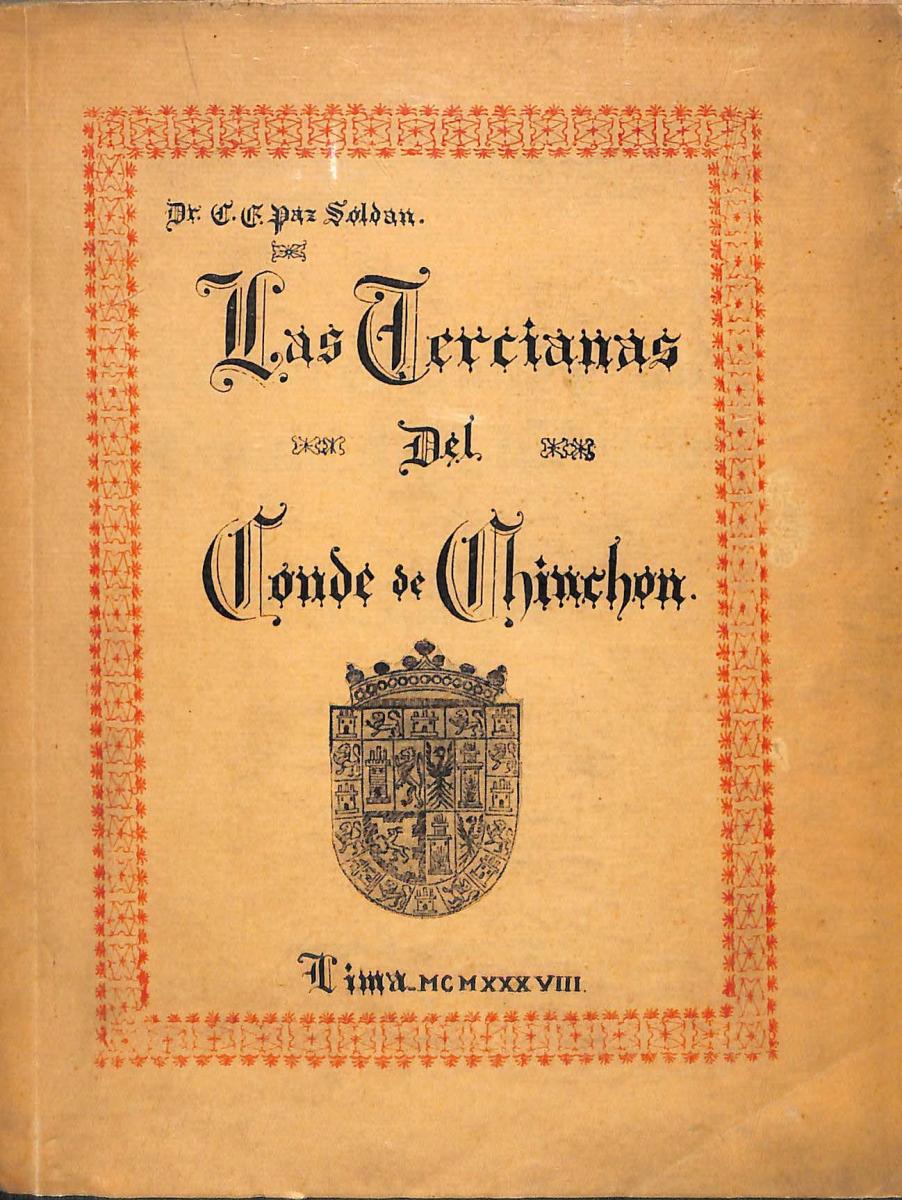 Paz Soldan, C.E. Las Tercianas del Conde de Chinchón. Según el Diario de Lima de Juan Antonio Suardo. Lima: Ediciones de La Reforma Médica, 1938.
Paz Soldan, C.E. Las Tercianas del Conde de Chinchón. Según el Diario de Lima de Juan Antonio Suardo. Lima: Ediciones de La Reforma Médica, 1938.
According to a legend, quinine arrived in Europe in 1638, thanks to Francisca Enríquez de Rivera, Countess of Chinchón and Viceroy of Peru. After the bleeding that was performed on her to cure her of a serious episode of fever proved ineffective, she recovered thanks to the dust from which she arrived from Loja (now Ecuador).
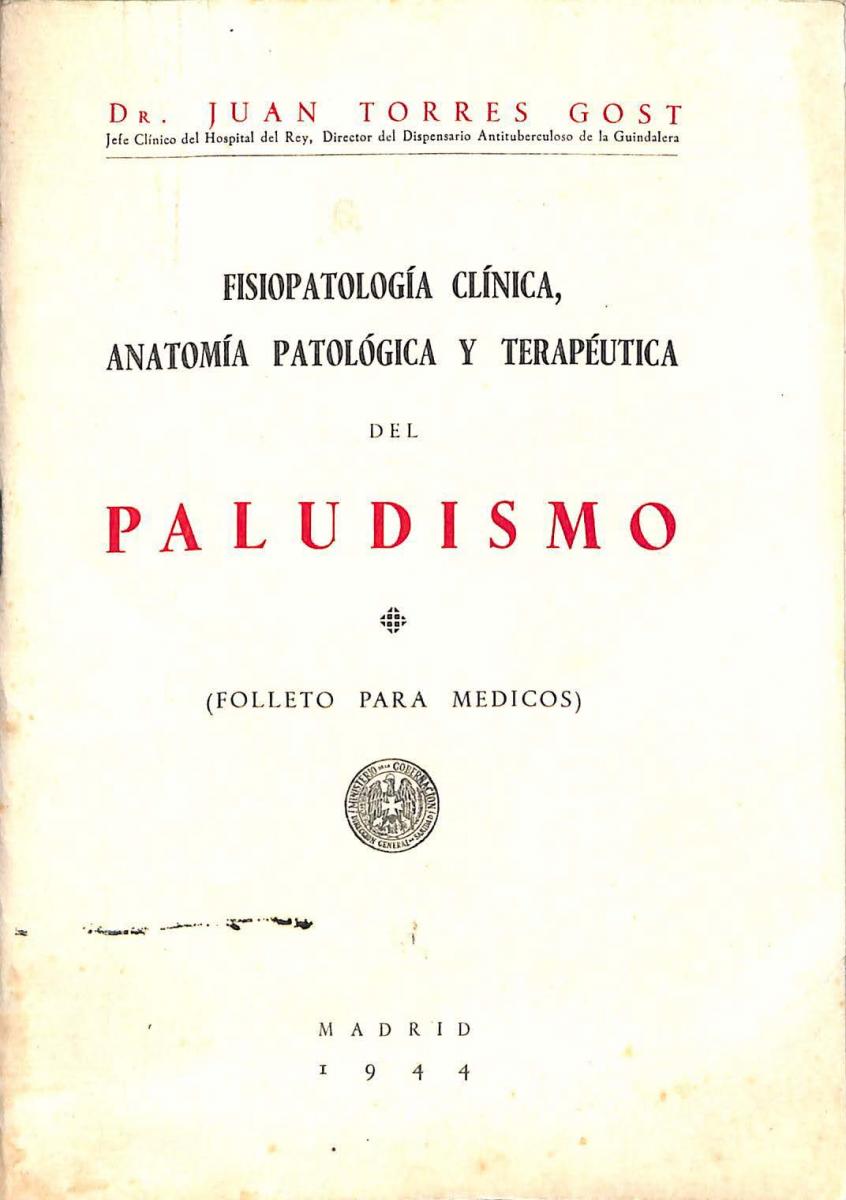 Torres Gost, J. Fisiopatología clínica, anatomía patológica y terapéutica del paludismo (folleto para médicos). Madrid: Dirección General de Sanidad, 1944.
Torres Gost, J. Fisiopatología clínica, anatomía patológica y terapéutica del paludismo (folleto para médicos). Madrid: Dirección General de Sanidad, 1944.
 Selfa, J. Paludismo en la infancia. Madrid: Dirección General de Sanidad, 1944.
Selfa, J. Paludismo en la infancia. Madrid: Dirección General de Sanidad, 1944.
Monograph on the consequences of malaria in children.
 Lozano Morales, A. Quimioterapia del paludismo, estado actual ante la endemia española. Madrid: Ministerio de la Gobernación, Dirección General de Sanidad, 1945.
Lozano Morales, A. Quimioterapia del paludismo, estado actual ante la endemia española. Madrid: Ministerio de la Gobernación, Dirección General de Sanidad, 1945.
Brochure for doctors written by Álvaro Lozano Morales, a doctor from Extremadura and one of the great Spanish malariologists. He was the director of the Instituto Antipalúdico de Navalmoral de la Mata.
 Rico-Avello, Carlos. Carlos II, Sus "tercianas", hechizos y dolencias. Madrid: Revista de Sanidad e Higiene Pública, 1948.
Rico-Avello, Carlos. Carlos II, Sus "tercianas", hechizos y dolencias. Madrid: Revista de Sanidad e Higiene Pública, 1948.
It is well known that Charles V died in Yuste of malarial fevers. This monograph, however, describes the tercianas of Charles II, the enchanted monarch.
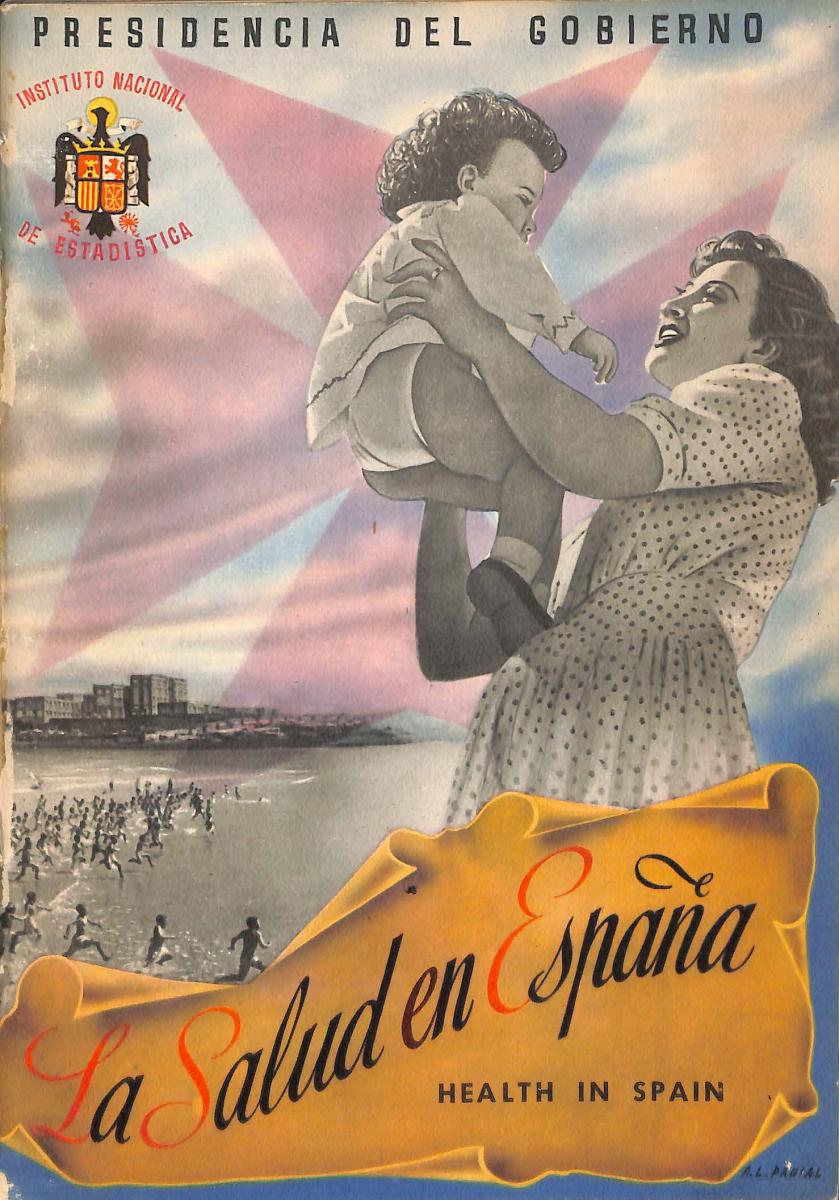 La salud en España. Madrid: Instituto Nacional de Estadística, Presidencia del Gobierno, 1954.
La salud en España. Madrid: Instituto Nacional de Estadística, Presidencia del Gobierno, 1954.
Government brochure with basic statistics on the main health problems in post-war Spain. Includes a page on malaria.
Postcard commemorating the decline of malaria cases in the postwar period. Throughout history, Spain had been an endemic country of malaria. In the early twentieth century, about 4,000 people died each year from the disease. With the advent of quinine and improved health conditions, however, the number of cases began to decline markedly. However, after the Civil War, malaria rebounded and became a public health problem again; in 1941 it was the eleventh cause of death in the country! Finally, the use of new antimalarial products, the introduction of DDT and the improvement of hygienic conditions managed to end the transmission of the disease. The last death from indigenous malaria occurred in 1959, during the Franco regime, and the last cases declared were in 1961. Spain was one of the last Western countries to be declared free of malaria by the WHO in 1964.
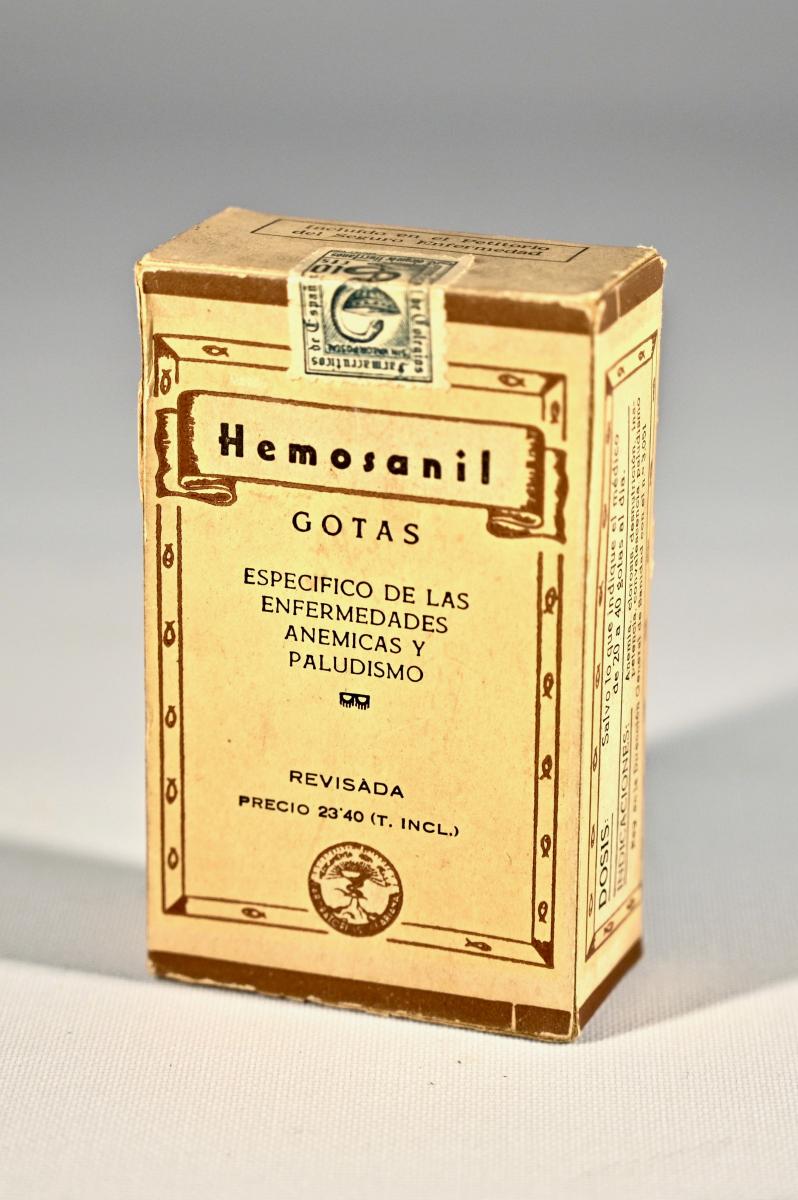 Laboratorios Clariana. Hemosanil Gotas. Específico de las enfermedades anémicas y paludismo. Valencia: Laboratorios Clariana. 23.40 pessetes.
Laboratorios Clariana. Hemosanil Gotas. Específico de las enfermedades anémicas y paludismo. Valencia: Laboratorios Clariana. 23.40 pessetes.
 Dr. Camacho. Píldoras del Doctor Camacho. Badajoz: Dr. Camacho.
Dr. Camacho. Píldoras del Doctor Camacho. Badajoz: Dr. Camacho.
The boat, from the early twentieth century, cost 6.30 pesetas. As a curious note, it reads: We warn patients that with the use of our pills their urine will turn greenish blue.
 Madrigal, A. Píldoras febrífugas infalibles. Barco de Ávila: Farmácia y Laboratorio de Madrigal.
Madrigal, A. Píldoras febrífugas infalibles. Barco de Ávila: Farmácia y Laboratorio de Madrigal.
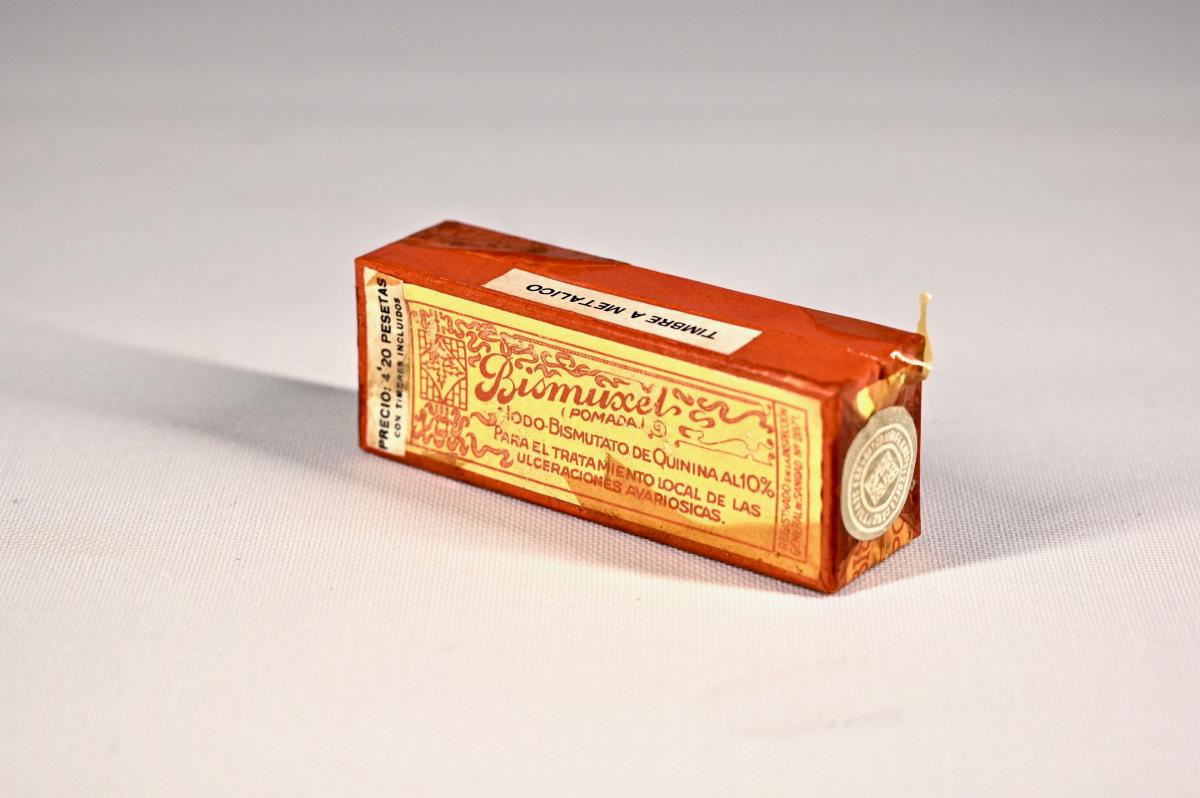 Laboratorio Dr. Fernández de la Cruz. Bismuxel (Pomada). Para el tratamiento local de las ulceraciones avariosicas. Sevilla: Laboratorio Dr. Fernández de la Cruz.
Laboratorio Dr. Fernández de la Cruz. Bismuxel (Pomada). Para el tratamiento local de las ulceraciones avariosicas. Sevilla: Laboratorio Dr. Fernández de la Cruz.
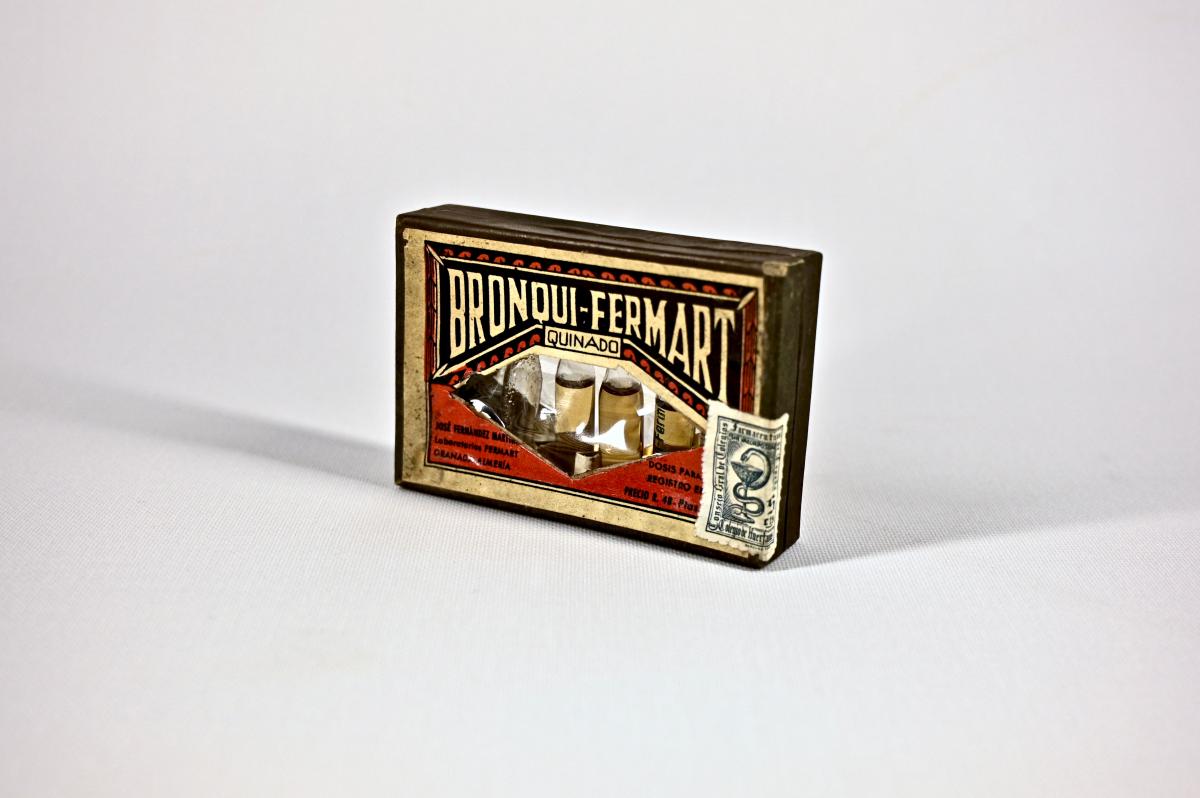 Laboratorios Fermart. Bronqui-fermart quinado. Granada: Laboratorios Fermart.
Laboratorios Fermart. Bronqui-fermart quinado. Granada: Laboratorios Fermart.
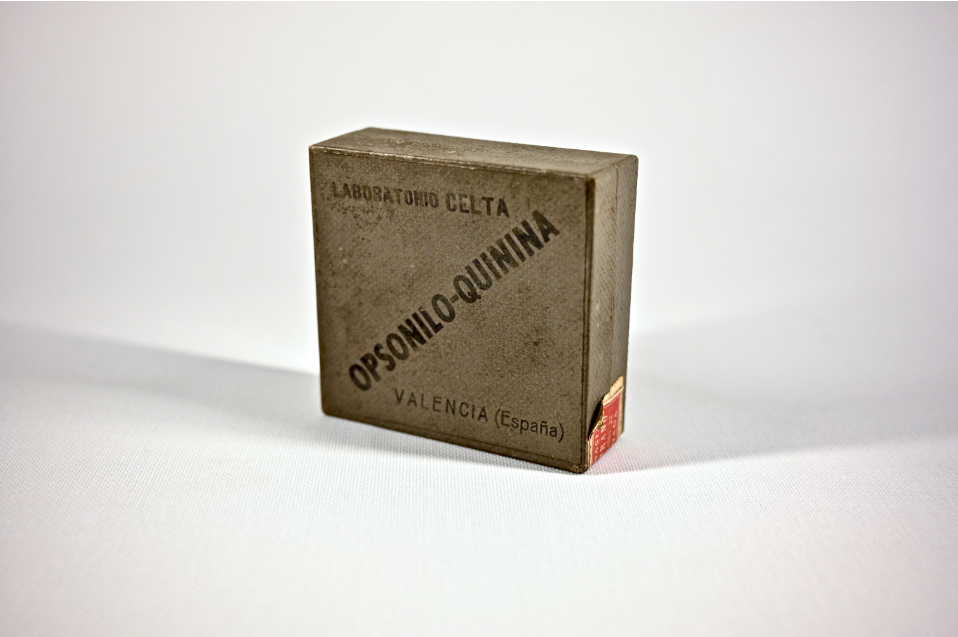 Laboratorios Celta. Opsonilo-Quinina Inyectable. Valencia: Labotatorios Celta.
Laboratorios Celta. Opsonilo-Quinina Inyectable. Valencia: Labotatorios Celta.
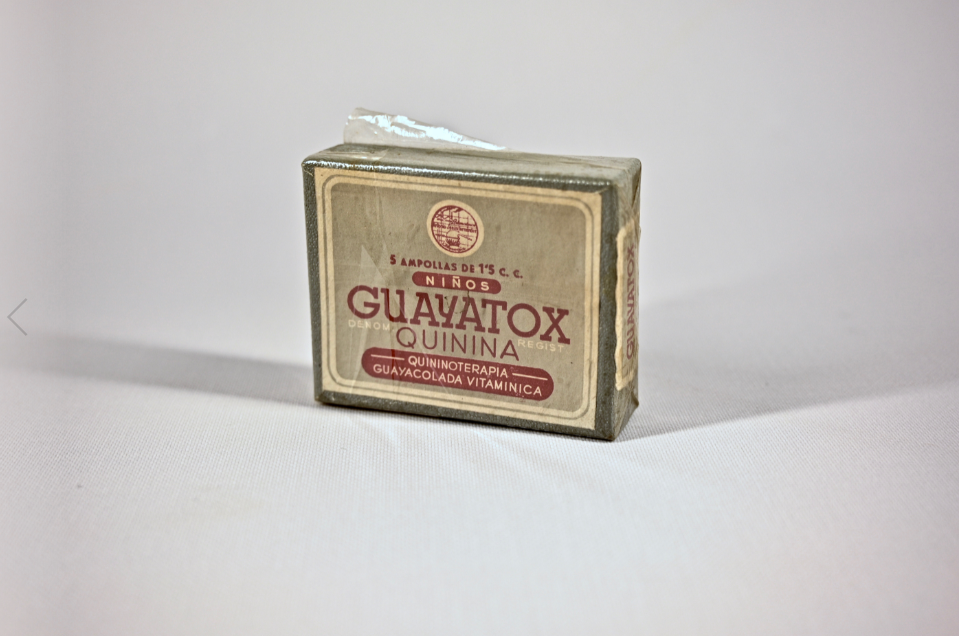 Laboratorios Químico-Farmacéuticos Antonio Jesús Fernández. Niños Guayatox Quinina. Quininoterapia Guayacolada vitamínica. 5 ampollas de 1.5cc. Almería: Laboratorios Químico-Farmacéuticos Antonio Jesús Fernández. 11.50 pessetes.
Laboratorios Químico-Farmacéuticos Antonio Jesús Fernández. Niños Guayatox Quinina. Quininoterapia Guayacolada vitamínica. 5 ampollas de 1.5cc. Almería: Laboratorios Químico-Farmacéuticos Antonio Jesús Fernández. 11.50 pessetes.
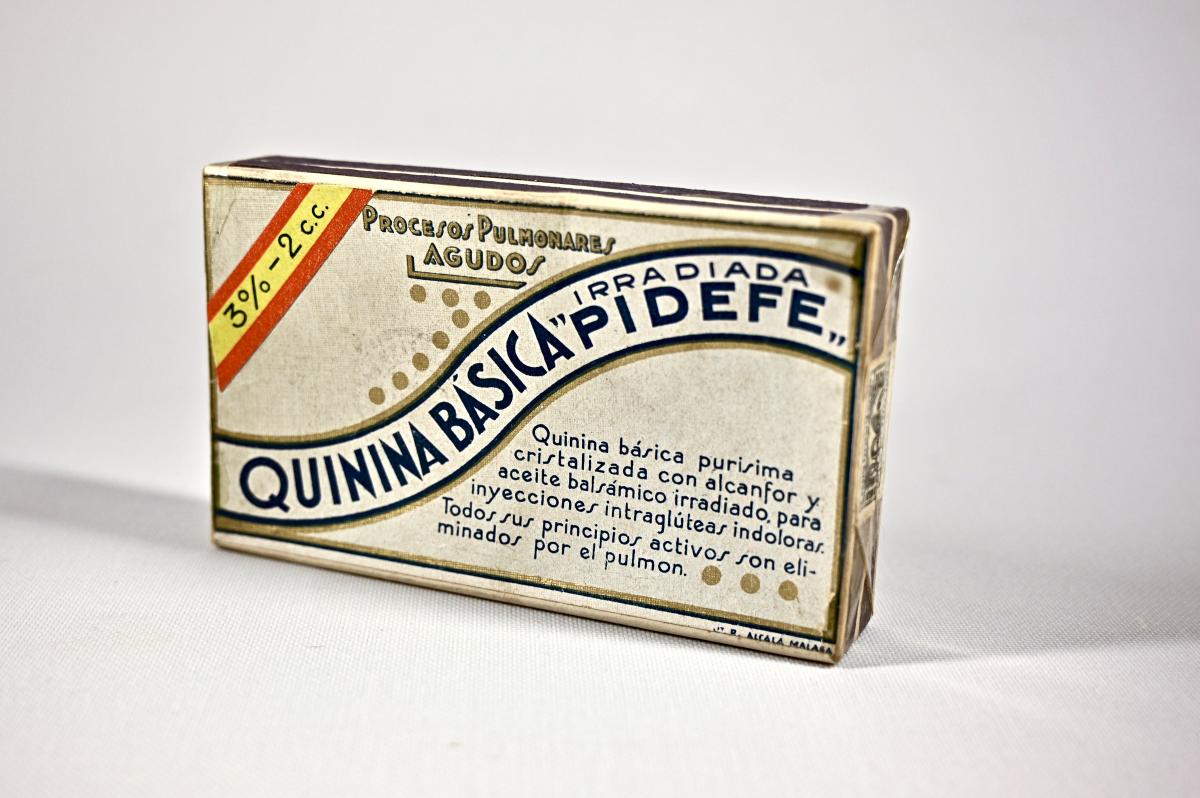 Laboratorios Pidefé. Quinina Básica Irradiada "Pidefe". Procesos pulmonares agudos. Quinina básica purísima cristalizada con alcanfor y aceite balsámico irradiado para inyecciones intraglúteas indoloras. Todos sus principios activos son eliminados por el pulmón. Málaga: Laboratorios Pidefé. 18.08 pessetes.
Laboratorios Pidefé. Quinina Básica Irradiada "Pidefe". Procesos pulmonares agudos. Quinina básica purísima cristalizada con alcanfor y aceite balsámico irradiado para inyecciones intraglúteas indoloras. Todos sus principios activos son eliminados por el pulmón. Málaga: Laboratorios Pidefé. 18.08 pessetes.
 Mapa de la distribución del paludismo en España según los datos de mortalidad del Instituto Geográfico y Estadístico (1900) y los de morbilidad proporcionado por los colegios de Médicos y otros informes. Dins de Pittaluga, G. Investigaciones y estudios sobre el paludismo en España. Barcelona: Tip. La Académica, 1903.
Mapa de la distribución del paludismo en España según los datos de mortalidad del Instituto Geográfico y Estadístico (1900) y los de morbilidad proporcionado por los colegios de Médicos y otros informes. Dins de Pittaluga, G. Investigaciones y estudios sobre el paludismo en España. Barcelona: Tip. La Académica, 1903.
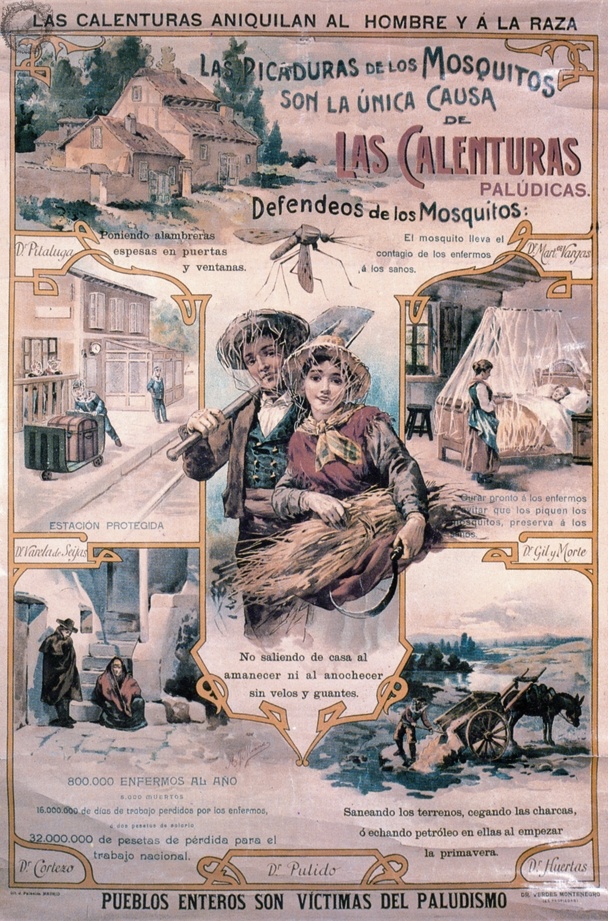 Comisión para el Saneamiento de Comarcas Palúdicas. Cartell de propaganda de la lluita antipalúdica: Las calenturas aniquilan al hombre y a la raza. Las picaduras de los mosquitos son la única causa de las calenturas palúdicas. Defendeos de los mosquitos. Pueblos enteros son víctimas del paludismo. Madrid: Lit. J. Palacios, 1920.
Comisión para el Saneamiento de Comarcas Palúdicas. Cartell de propaganda de la lluita antipalúdica: Las calenturas aniquilan al hombre y a la raza. Las picaduras de los mosquitos son la única causa de las calenturas palúdicas. Defendeos de los mosquitos. Pueblos enteros son víctimas del paludismo. Madrid: Lit. J. Palacios, 1920.
